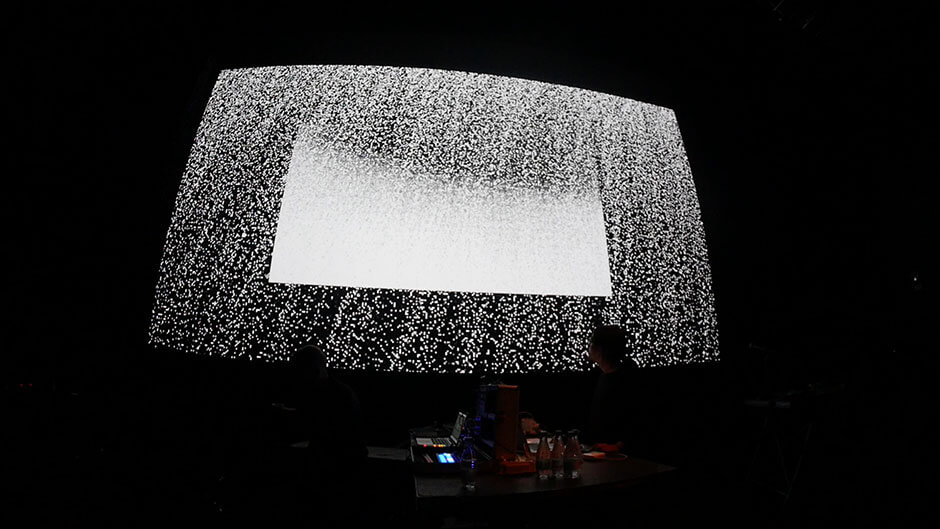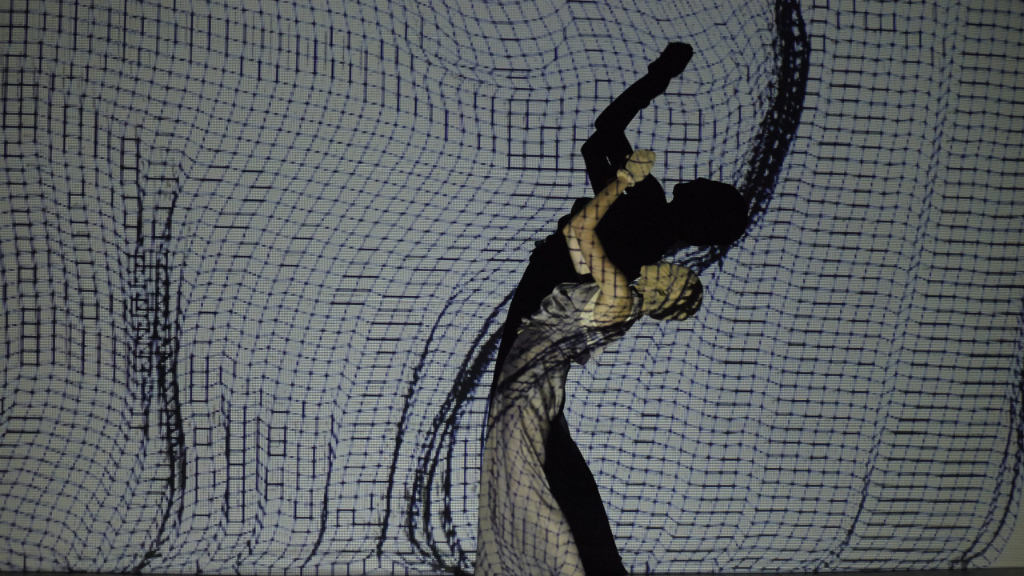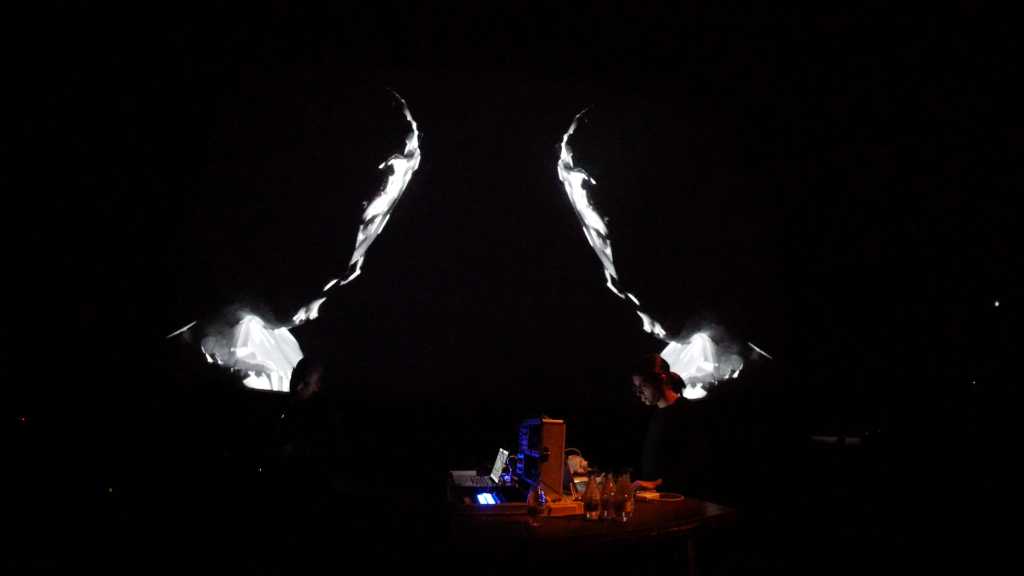Interview by Jacobo García

Marta Verde feels at home crossing borders between fields and techniques. She never gets tired of exploring what technology puts on the plate, always hungry for the next tool or trick. Originally from Galicia, a green, coastal, remote region in the northwest corner of Spain, but now based in Madrid.
Her field of work can be defined as broad without a shadow of a doubt; programming live visuals for dancers by capturing their motions, fabricating wearables, generative graphics or interactive lighting design, among many others. One of her more recognisable aspects is her adeptness to build custom apparatus, mechanisms or toys which take a hybrid form, then writing software to control them, coalescing together to form the core of her visual sets and installations.
Two diffuse black and white forms, one looking against the other, this is how Marta starts her performance along Madrid-based music producer José Venditti, better known as NegroNegro (meaning BlackBlack). The piece, named √ÅL ∆EL ØMÅ®, has been developed specifically for the Live Cinema section of Seminci, Valladolid International film festival, one of the most important festivals in Europe regarding independent and auteur films.
Those forms eventually mutate into sculptural faces, each one in dialogue with the other through discrete movements, colour changes, merges and superpositions. With the song approaching its end, NegroNegro builds tension as the images go static in stark juxtaposition.
The whole concert is a homage to Spanish experimental film pioneer José Val del Omar, the homage clearly evident in the concealed title. The influence of Val del Omar on Marta doesn’t stop here. He was a recognised inventor who, as Marta, created small toys that he used in his films to break the traditional perceptions of cinema by accumulating and juxtaposing images to create different points of view and perspectives for the spectator. At the end of the show, you can see a similar approach in Marta’s visuals, only that, in this case, they’re created by digital means.
Her work with stage director Jordi Purtí combines contemporary dancers with reactive visuals producing breathtaking, sublime visual poems. The pure aesthetics of motion are wonderfully threaded with a clean aesthetic, the dancer, flowing, being the centre and source of visual thrill, external to itself but internal, all at the same time. The show, Pirouette en Re Menor, is carried out by Múcab Dans, a dance company from Catalonia specialising in contemporary dance with an edge for technology and multimedia. The production toured cities around Europe from 2011 to 2013.
Our short journey on Marta’s work should give us a few clues: her work draws on the past; by building upon the work of local pioneers and innovators, her output walks along classical forms of expression, always blending it, with care, in a pleasant, aesthetic way with the newest, tirelessly ever looking for new facets of expression. Technology is the best tool for us to relish in Marta’s creative mind. Technology is how Marta chooses to find us through the noise of today’s world.


For those that are not familiar with your work, could you tell us a little bit about your background and your development as an artist?
Well, my original background is in Fine Arts. I used to paint, draw, engrave and all that analogue stuff, but I have always been fascinated by technology since I was a child. When I was finishing my degree, I started doing visuals with a lovely group of friends about 10 years ago; I had developed some video art before, but I had never heard about real-time video, and I was very intrigued by the concept.
We were a multidisciplinary group which included dancers, and because of this physical aspect, I started wondering about how to do certain stuff (like projecting only on their white dresses), and I realised that I had to learn to code to develop my own tools to reach my desired results. After that, I specialised in digital arts and digital techniques for the stage. I started working in the field of digital arts, and some years ago, with the need for prototyping, I introduced myself to the makers’ world.
I have managed to merge the best of two worlds: artistic and technical. I can solve the issues I encounter in a creative way but based on technology. With this mixed background, I have met amazing people and have collaborated on many different projects and initiatives: doing visuals with a classical flute player, we had the premiere in NY and never performed that show again, programming interactive content for advertising, events, festivals or lighting design, doing wearables for fashion weeks, national television campaigns, teaching at University, great folk festivals in Portugal, running crazy non-sleeping hackathons, taking care of interactive installations and exhibitions.
Can you explain to us a bit more about what kind of devices you build for a specific set? What is the process behind it?
Sometimes I think I complicate matters using different techniques, software and devices simultaneously. It seems that I enjoy risk in my life. But this is because I don’t feel really attached to any specific tool; I see all of them as they are, as tools indeed, they are only a way to arrive at the desired result, or sometimes, to find something you didn’t expect when you started.
That’s why at the same performance, I can manage 3 or maybe 4 different software or platforms; depending on the outcome I need, I decide to use one or another. In terms of coding the content, I’m used to setting up my own control panel to manage the different scenes and control the parameters and inputs.
I base much of my work on loops, repetition, simplicity, and textures. In my last project, I’m using analogue components more often than ever, trying to mix the digital and analogue worlds thanks to digital fabrication and fast prototyping. Also, I am recording my own footage to later post-produce it and adapt it to my needs. Honestly, I follow my feelings and intuition to develop the sets. There is no specific rule.
You’re a truly multidisciplinary artist. Your works involve visuals, generative content creation, wearables, and fabrication; which one is more challenging for you?
For now, I’m very intrigued about Shaders and GLSL. It’s the next step for me; being able to develop more stable and high-performance real-time graphics. Because my background is not technical, I found the curve of this type of learning quite steep. I want to be a better programmer, even if I can really self-proclaim myself as one. Also, I am learning about a more deep and more technical use of digital fabrication. Since I’m working at a Fab Lab, I can do my own research and take advantage of having all this machinery close and available.
What artistic discipline you’ll love to get involved in the near future?
I miss working with dancers and performers. Scenic arts are one of my favourite fields. I want to focus on my own artist or performative work rather than work as a mercenary provider for big companies, I may be a fool, believing in unicorns. I want to work for myself, not for others. I’m also super interested in modular analogue video synthesis. I want to try it when I have time.
You’re performing at Mira Festival alongside Christoph De Babalon. His music is rooted in the 90s rave imagery. How are you preparing your visuals? Are you taking these aesthetic aspects into account?
I didn’t live that moment in the 90s, so I can’t really apply “ideas” or aesthetics with which I’m not familiar, to be honest. I have listened to his music and live sets to understand the rhythms, mood and vibe and let my imagination figure out which style or aesthetics fits. I think that visual artists have our own tricks and aesthetic obsessions, and we always look for different ways to apply them.
The magic happens when we can link these two languages to a closed performance. We both have our own styles. Mira festival made the curatorial work of getting us together for this event, thinking that our work could complement each other well. We talked a little before the festival, he showed me the musical line of his set, and I showed him the last stuff I was working on; the idea is to freely develop our own styles and find a point in common, If I can’t ask him to play a specific note, he shouldn’t ask me to project a specific colour.
This is a very challenging performance; first, I’m not used to working with artists I don’t know or perform in this kind of live set within a festival context. Second, the aspect ratio of the screen in the main stage is very special in terms of composition, ultra-extended and panoramic. This Saturday, I’ll split the performance into three scenes, maybe I did some spoilers on social networks, but It will be mainly darkness, distorted human forms, glitches and more delicate but geometric textures.
What is your chief enemy of creativity?
Conformity. Creativity stays alive because of curiosity and self-challenge.
You couldn’t live without…
Maybe I can look like a crazy workaholic, but I can’t imagine life without a close upcoming deadline or project. And pipas1, of course.





